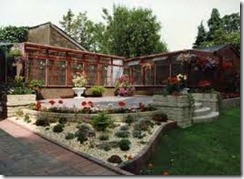 Alpines have special needs. They are high-altitude plants that, in their natural habitat, are covered in snow in winter. They are small and compact, and can withstand ferocious winds and rock falls. A bright position and excellent drainage are vital. A huge range of good alpine plants can be grown in special containers kept in the garden, where they will look very unusual. Covering the containers’ gritty soil surface with a layer of pebbles and small rocks gives a feel of how they look in the wild, shows up their often delicate flowers, and makes a marvelous slug deterrent. You can combine them with some drought-tolerant plants, such as cacti and succulents, for a desert effect.
Alpines have special needs. They are high-altitude plants that, in their natural habitat, are covered in snow in winter. They are small and compact, and can withstand ferocious winds and rock falls. A bright position and excellent drainage are vital. A huge range of good alpine plants can be grown in special containers kept in the garden, where they will look very unusual. Covering the containers’ gritty soil surface with a layer of pebbles and small rocks gives a feel of how they look in the wild, shows up their often delicate flowers, and makes a marvelous slug deterrent. You can combine them with some drought-tolerant plants, such as cacti and succulents, for a desert effect.
When buying plants it is worth visiting specialist alpine nurseries which will have a far bigger selection than garden centers, and possibly some of the latest finds. They will also give good tips for growing alpine plants.
HOUSELEEKS
TOP LEFT: Get away from the idea that all plinths are naked without a classical statue. As this one shows, a bowl of houseleeks makes an extremely novel feature.
THE TROUGH GARDEN
LEFT: Alpines are addictive and you end up planting every bowl you can find. Note how the immediate area has been covered with gravel to imitate the scree of an alpine landscape.
WALL PLANTINGS
RIGHT: Some alpines love the rocky cracks on the tops of walls. Alternatively they can be safely placed here in shallow bowls. It raises them up to eye level. This collection includes Sedum spathulifolium “Purpureumâ€, Oxalis triangularis, and Campunula garganica “Dickson’s Goldâ€

Deprecated: strpos(): Passing null to parameter #1 ($haystack) of type string is deprecated in /home/agriviek8Qv/agriviet.net/public_html/wp-includes/comment-template.php on line 2522